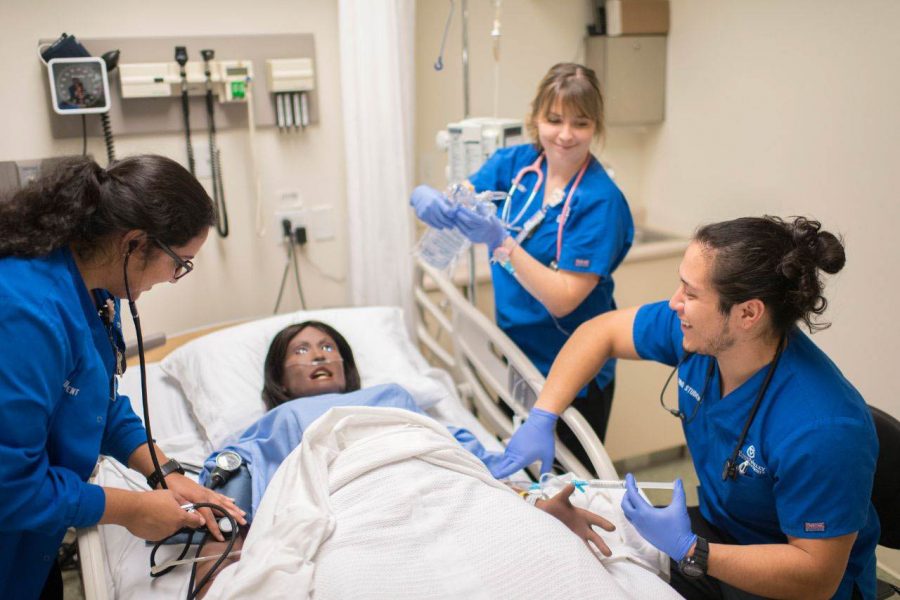GV Simulation Center adopts to virtual and socially-distanced simulation models
Feb 20, 2021
The Grand Valley State University Simulation Center, located in the Cook-Devos Center for Health Sciences, has found clever ways throughout the past year to continue giving nursing students hands-on healthcare experience while following state and university COVID guidelines.
During the fall semester, the Sim Center introduced many new ways of conducting clinical and lab examinations for its students, faculty, healthcare professionals and team members to participate in.
“While the majority of the GVSU community continued to work and learn remotely, the sim team developed a High Fidelity Remote Simulation (HFRS) option that allowed the College of Nursing to augment the clinical education for nursing students; a remote standardized patient telemedicine platform for multiple health professions; our PT and OT program conducted labs in the parking lot at RFH ensuring proper COVID safety guidelines were met; and we created a Student-Directed Remote Simulation (SDRS),” said Multimedia Coordinator Kelly Klerk.
The HFRS allows students, observers, faculty and simulation operators to remotely view a patient exam room while a sim team member takes on the role of an acting nurse and responds to directions from the primary student nurse and student charge nurse. The simulation operators display vitals, images, videos and play audio for students who then voice their opinions on what type of care they would deliver to the patient as if they were in the room as well. The simulation ensures the safety of all participants while also making it engaging and as realistic as possible through its virtual model.
Similarly, the remote standardized patient platform gives students the opportunity to practice examinations using remote telemedicine like those used in the healthcare community. The Sim Center also developed the SDRS, which uses pre-recorded and scripted videos of standardized patients for students to examine with a simulation operator.
During a normal semester, the Sim Center would work with faculty to provide students with engaging hands-on experiences for all aspects of healthcare delivery in a safe and controlled environment as well as hold interprofessional events where students learn from, with and about different healthcare professions. While some of their operations have had to go remote, team members at the Sim Center adjusted to COVID guidelines to keep in-person labs available to GVSU students.
“We were able to continue with a majority of their health-related academic labs throughout the year by following social distancing guidelines and requiring students and faculty to wear personal protective equipment and followed our Covid-19 cleaning policy and procedures,” Klerk said. “We have fewer students in exam rooms at a time, which makes for longer days for faculty and the sim team, but it is absolutely worth every minute!”
Much like many others at GVSU, the Sim Center has found technology to be the biggest challenge in their virtual simulations.
“It takes a significant amount of prep work to ensure all the Simulation events are as seamless as possible,” Klerk said. “The key is to anticipate and troubleshoot issues as quickly as possible.”
Despite the trouble from moving to virtual simulations, the Sim Center continues to adapt and improve its new platforms to ensure students are receiving high-quality and engaging simulations. The center has also been able to work more closely with faculty from other departments to create new events and expand their lab options.
“We truly work to provide the best experience for each student. It is amazing how well students have adapted to our changing environment,” Klerk said. “Our hope is that students walk away from each event with a better understanding of how to deliver effective healthcare as they grow into their professions. The biggest takeaway with what we are doing now is that the possibilities are limitless.”























